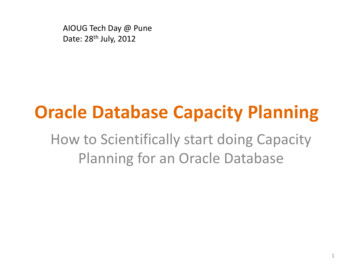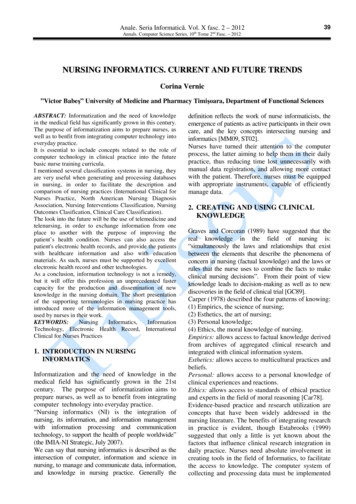
Transcription
AIOUG Tech Day @ PuneDate: 28th July, 2012Oracle Database Capacity PlanningHow to Scientifically start doing CapacityPlanning for an Oracle Database1
About Me 8 years of experience in Oracle Database Performance Optimization and ITServices/Infrastructure Capacity Planning. Certified Oracle DBA – OCP 9i, 10g, 11g, RAC Expert Other Certifications – ISO/20000 Certified Auditor, ITIL Practitioner V3, BaseSAS Currently working with Barclays Bank PLC as a Capacity Manager When time allows I blog at http://neerajbhatia.wordpress.com/Neeraj Bhatia Oracle Database Capacity Planning: How to Start?2
What is Capacity Planning“Capacity Planning is the process of predicting when future loadlevels will saturate the system and determining the most costeffecting way of delaying system saturation as much as possible”- by Daniel A. Menasce and Virgilio A.F. Almeida(Authors of Capacity Planning for Web Services: Metrics, Models & Methods)Neeraj Bhatia Oracle Database Capacity Planning: How to Start?
Systematic Approach to Capacity Planning1.2.3.4.5.6.7.8.State GoalsDefine the System ConfigurationList Database ServicesIdentify Right MetricsCollect DataAnalyze and Model DataInterpret the Data and ResultsPresent ResultsNeeraj Bhatia Oracle Database Capacity Planning: How to Start?4
Identifying Application MetricsUsers of Business ServicesBusiness Transactions(ATM Cash withdrawal etc)IT Service(ATM Service)IT Service Components(Application server, Database Application)IT Infrastructure(Server, Network components etc)Neeraj Bhatia Oracle Database Capacity Planning: How to Start? Talk with Business and applicationteams to identify good set of metrics bywhich growth and workload of businessis measured. Examples – Total ATM transactions,Active Users, total login on an onlinebookstore etc Underlying Database workload metrics– transactions/sec, user calls/sec etc CPU Utilization, Memory Utilization5
The Future lies in the History"I have seen the future and it is very much like the present,only longer."--Kehlog Albran, The ProfitThis philosophy is actually a concise description of statistical forecasting. We searchfor statistical properties of a time series that are constant in time - trends, seasonalpatterns, correlations etc. We then predict that these properties will also describe thefuture.Neeraj Bhatia Oracle Database Capacity Planning: How to Start?6
Data History, History, History!!! The precision of forecasted results lies in quantity of historical data; longer the datamore the chances of precise results. In small shops AWR schema is the best place to keep the data. Big enterprisesgenerally upload the data to CMIS. Data retention value should be large enough to keep seasonal trend, periodicactivities. Retention value of 13 months is recommended in most of the cases.Database metrics pertaining toCapacity and Performance from AWRSchema and v sysstat etcCMISOther data in CMIS Business Metrics Future Business Demand Resource Utilization Data Capacity Plans and ReportsNeeraj Bhatia Oracle Database Capacity Planning: How to Start?7
Time for some Statistics recap Most of the times data show a tendency to group around a central point and thissingle typical value can be used to describe the entire data set. These measures areArithmetic Mean and the Median. The Arithmetic Mean (aka Average) is most commonly used metric to summarizethe numeric data. It is calculated by summing all the values and then dividing the totalnumber of observations involved. Arithmetic Mean are vulnerable to the extreme points, which are known asOutliers. Let’s take an example of hourly CPU Utilization for 6-hours window as:28%, 31%, 30%, 32%, 95% and 29%Mean CPU Utilization 41%Eliminating 95% as an Outlier, Mean CPU Utilization 30% Because it is based on every observation, the arithmetic mean is significantlyaffected by Outliers. In such cases, only reporting the arithmetic mean may present adistorted representation of what the data are conveying.Neeraj Bhatia Oracle Database Capacity Planning: How to Start?8
Median & Percentile The Median is the middle value in the ordered set of data. In case of even number ofobservations, the Median is calculated by taking the average of two middleobservations. Consider our previous example of hourly CPU Utilization,28%, 29%, 30%, 31%, 32%, 95% (Data sorted in ascending order)Median Average (30%, 31%) 30.5% The Median is unaffected by any extreme observations. When summarizing a set of data that has Outliers, you should report the median orbetter both the mean and median. A Percentile is the value below which a certain percent of observations fall. Forexample, the 70th percentile is the value below which 70 percent of the observationsmay be found. Percentile in Oracle Database environment can be used to set Adaptive thresholds forPerformance/Workload metrics, analyze and summarize database performance data. MS Excel has inbuilt formula PERCENTILE(Data Array, k) to calculate kth percentile ofvalues. For example to calculate 90th percentile, use PERCENTILE(Data Array, 0.9)Neeraj Bhatia Oracle Database Capacity Planning: How to Start?9
Standard Deviation and Empirical Rule Although the arithmetic Mean give a central point around which all the values tendto cluster, but it doesn’t give us a clue about the variation in the data around themean. To evaluate the fluctuation around the mean a statistic measure called StandardDeviation is used. MS Excel has inbuilt formula STDEV(data array) to quickly calculate the Standarddeviation for a given set of numbers. The Standard Deviation measure the “average” scatter around the mean – someobservations are larger than the mean while some of them can be lower. The Empirical Rule of statistics states that: About 68.27% of the values lie within 1 standard deviation of the mean. Similarly, 90% of the values lie within 1.645 standard deviations of the mean. Nearly all (95%) of the values lie within 1.960 standard deviations of the mean. Thus the arithmetic mean and the standard deviation usually helps define wheremajority of the data values are clustering.Neeraj Bhatia Oracle Database Capacity Planning: How to Start?10
Little Law’s FormulasServiceTimeUtilization of aserverArrival RateNumber ofCPUsCan also re-written as:Neeraj Bhatia Oracle Database Capacity Planning: How to Start?11
Case Study: DB Capacity PlanningProblem Statement: You are an Oracle DBA. The Business wants to know how muchadditional workload current database can support AND how much additional capacity (ifany) would be required to support double the workload (around 10% per month).Step-1 State Goal: How much load of some particular business activity database can support,before running “out of gas”? If the workload grows by 100% (around 10% every month), when we willneed to add more capacity to the system?Step-2: Define the System ConfigurationOracle Database 11.2 running with 8 CPUs and 16 Gigs memoryStep-3: List Database ServicesDatabase is primarily part of an Order management system in an OLTP environment.Neeraj Bhatia Oracle Database Capacity Planning: How to Start?
Case Study: DB Capacity PlanningStep-4 Identify Right MetricsYou had discussion with Business to understand how they measure business growth and cameto know that #orders and #order lines give a clear picture to them. Then you discuss withapplication team to understand which columns in the application tables hold this data.Step-5: Collect DataFurther you have agreed with relevant application teams to have these metrics on an hourlybasis. You collect CPU utilization data from any monitoring tool installed on the server, nativeOS tool or from AWR tables ( Host CPU utilization in DBA HIST SYSMETRIC SUMMARY).Step-6: Analyze and Model DataYou correlate #Order and #Order lines with the host CPU utilization to see which Applicationmetric is driving the CPU utilization on underlying database.Avg CPU can be explained by the OrderLines/hour 58.71 % of the time.Neeraj Bhatia Oracle Database Capacity Planning: How to Start?
Case Study: DB Capacity PlanningFor example Service Time (68.37% * 8) / 976 0.00560369Neeraj Bhatia Oracle Database Capacity Planning: How to Start?
Case Study: DB Capacity Planning70th PercentileArrival RateNeeraj Bhatia Oracle Database Capacity Planning: How to Start?
Summarizing & Reporting the Findings Effecting Capacity Planning involves not only analyzing the data but alsosummarizing the key findings and presenting it to the relevant people.Step-8: Present Results Current Database Capacity can support 35% additional order linesworkload which means around we are safe for next 3 - 4 months. We would need 4 additional CPUs to support double Order linesworkload.Neeraj Bhatia Oracle Database Capacity Planning: How to Start?16
Capacity Planning Tools A tool can help you but that's not the end of the world. For big enterprise environment a sophisticated tool is recommended, which canease your life. For small shops, MS Excel is a low-cost solution for Performance Visualization,Capacity Planning and Data Analysis.Neeraj Bhatia Oracle Database Capacity Planning: How to Start?17
Quotation"I hear and I forget. I see and I remember. I do and I understand."-- Chinese ProverbThe best way to learn a subject is to apply the concepts to a real system. Thetechniques presented in this presentation may appear simple on the surface, theirapplications to real world may offer a different experience.Neeraj Bhatia Oracle Database Capacity Planning: How to Start?18
ReferencesAdditional Resources: My blog - http://neerajbhatia.wordpress.com/ Email -neeraj.dba@gmail.comNeeraj Bhatia Oracle Database Capacity Planning: How to Start?
Neeraj Bhatia Oracle Database Capacity Planning: How to Start?
Title: The Future lies in the











